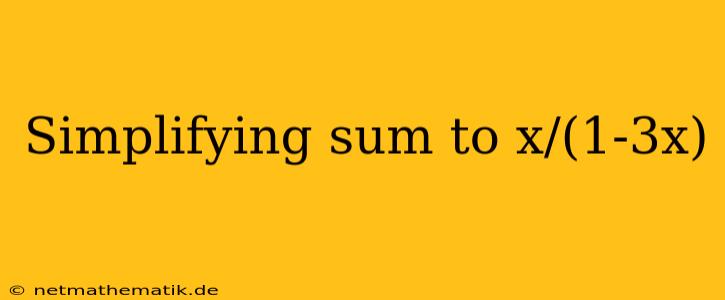In mathematics, simplifying expressions is a fundamental skill that allows us to express complex ideas in a more concise and manageable form. This process often involves combining like terms, factoring, and applying various algebraic rules. One common type of expression that can be simplified involves fractions, particularly those with a polynomial in the numerator and denominator. One such expression is the simplification of a sum to the form x/(1-3x). This article delves into the process of simplifying such sums, exploring the steps involved and providing illustrative examples.
Simplifying Sums to x/(1-3x)
The expression x/(1-3x) represents a simplified form of a sum that can arise from various algebraic manipulations. Let's break down the steps involved in simplifying such sums.
Identifying the Pattern
The key to simplifying sums to x/(1-3x) lies in recognizing a specific pattern within the sum. This pattern involves terms that can be expressed as multiples of a common factor. For instance, consider the following sum:
x + 3x^2 + 9x^3 + 27x^4 + ...
Notice that each term in the sum is a multiple of the previous term. The first term is simply x, the second term is 3x times the first term, the third term is 3x times the second term, and so on. This pattern suggests the possibility of simplifying the sum.
Applying the Geometric Series Formula
The pattern observed in the previous example is characteristic of a geometric series. A geometric series is a series where each term is obtained by multiplying the previous term by a constant factor called the common ratio. In our example, the common ratio is 3x.
The sum of an infinite geometric series can be calculated using the formula:
S = a / (1 - r)
where:
- S is the sum of the infinite series
- a is the first term
- r is the common ratio
Applying the Formula to the Example
Let's apply this formula to our example sum:
- a = x (the first term)
- r = 3x (the common ratio)
Plugging these values into the formula, we get:
S = x / (1 - 3x)
Therefore, the simplified form of the sum x + 3x^2 + 9x^3 + 27x^4 + ... is x/(1-3x).
Generalization and Limitations
The method described above can be generalized to simplify any sum that exhibits the same pattern. The key is to identify the first term (a) and the common ratio (r) of the geometric series. Once these are known, the sum can be simplified using the formula S = a / (1 - r).
However, it's important to note that this method is only applicable to sums that converge. A geometric series converges only if the absolute value of the common ratio is less than 1 (|r| < 1). If |r| ≥ 1, the series diverges, and the sum cannot be simplified using this method.
Example: Simplifying a Finite Geometric Series
Consider the following finite geometric series:
1 + 2 + 4 + 8 + 16
Here, the first term (a) is 1 and the common ratio (r) is 2. Applying the formula for the sum of a finite geometric series:
S = a(1 - r^n) / (1 - r)
where n is the number of terms.
In this case, n = 5. Substituting the values into the formula, we get:
S = 1(1 - 2^5) / (1 - 2) = 31
Therefore, the sum of the finite geometric series 1 + 2 + 4 + 8 + 16 is 31.
Conclusion
Simplifying sums to the form x/(1-3x) involves recognizing the pattern of a geometric series, identifying the first term and common ratio, and applying the appropriate formula. This process allows us to express complex sums in a more compact and manageable form. However, it's crucial to remember the limitations of this method, as it is only applicable to convergent geometric series. By understanding the principles behind simplifying sums, we can gain a deeper appreciation for the elegance and power of algebraic manipulations.
